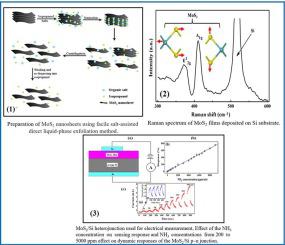当前位置:
X-MOL 学术
›
Inorg. Chem. Commun.
›
论文详情
Our official English website, www.x-mol.net, welcomes your
feedback! (Note: you will need to create a separate account there.)
A comprehensive review on synthesis and applications of molybdenum disulfide (MoS) Material: Past and Recent Developments
Inorganic Chemistry Communications ( IF 4.4 ) Pub Date : 2020-11-01 , DOI: 10.1016/j.inoche.2020.108200 Deepika Gupta , Vishnu Chauhan , Rajesh Kumar
Inorganic Chemistry Communications ( IF 4.4 ) Pub Date : 2020-11-01 , DOI: 10.1016/j.inoche.2020.108200 Deepika Gupta , Vishnu Chauhan , Rajesh Kumar

|
Abstract The evolutions of nanomaterials have played a significant role in altering the shape and structure of the materials at the nanoscale level to achieve desired applications. Early carbon nanotubes were considered to be an optimistic material for electronics but their incapacity to differentiate semiconducting and metallic phases results into development of Quasi two dimensional (Q2D) materials which include graphene, black phosphorous, 2D ZnO, hexagonal boron nitride, 2D honeycomb silicon, and layered transition metal dichalcogenides (TMDs) like molybdenum disulfide (MoS2) and Tungsten disulfide (WS2). Among them, molybdenum disulfide (MoS2) is considered as convincingly multipurpose material because it exhibits a capacity to show different properties as it changes from bulk to nanoscale. Single layer MoS2 is assuredly capable of post-silicon electronics due to its direct bandgap value i.e. (~1.9 eV). It exhibits a high on/off current ratio (108) at room temperature and mobility of about 200 cm2 (Vs)−1. Also based on structure, MoS2 has two characteristics (i) it possesses a hexagonal arrangement in which S-Mo-S atomic layers are covalently bonded (ii) Van der Waals interaction lies between the adjacent layers of MoS2 that makes it suitable for gas sensing purpose. At 300 K, MoS2 comprises thermal conductivity value 131 Wm−1 k−1. MoS2 consists of different polytypes. The promising properties and characteristics of MoS2 make it suitable for various practical applications. In this review, we try to cover the recent and past developments carried out in the field of 2D MoS2 material.
中文翻译:

二硫化钼(MoS)材料的合成与应用综述:过去和最近的发展
摘要 纳米材料的演变在纳米级改变材料的形状和结构以实现所需的应用方面发挥了重要作用。早期的碳纳米管被认为是一种乐观的电子材料,但由于它们无法区分半导体和金属相,因此开发了准二维 (Q2D) 材料,包括石墨烯、黑磷、二维 ZnO、六方氮化硼、二维蜂窝硅、和层状过渡金属二硫属化物 (TMD),如二硫化钼 (MoS2) 和二硫化钨 (WS2)。其中,二硫化钼 (MoS2) 被认为是一种令人信服的多用途材料,因为它在从块状到纳米级变化时表现出不同的特性。由于其直接带隙值,即(~1.9 eV),单层 MoS2 肯定能够用于后硅电子学。它在室温下表现出高开/关电流比 (108) 和约 200 cm2 (Vs)-1 的迁移率。同样基于结构,MoS2 具有两个特征 (i) 它具有六边形排列,其中 S-Mo-S 原子层共价键合 (ii) 范德华相互作用位于相邻的 MoS2 层之间,使其适用于气体传感目的。在 300 K 时,MoS2 的热导率值为 131 Wm-1 k-1。MoS2 由不同的多型体组成。MoS2 的有前途的性质和特性使其适用于各种实际应用。在这篇综述中,我们试图涵盖在二维二硫化钼材料领域最近和过去的发展。(~1.9 eV)。它在室温下表现出高开/关电流比 (108) 和约 200 cm2 (Vs)-1 的迁移率。同样基于结构,MoS2 具有两个特征 (i) 它具有六边形排列,其中 S-Mo-S 原子层共价键合 (ii) 范德华相互作用位于相邻的 MoS2 层之间,使其适用于气体传感目的。在 300 K 时,MoS2 的热导率值为 131 Wm-1 k-1。MoS2 由不同的多型体组成。MoS2 的有前途的性质和特性使其适用于各种实际应用。在这篇综述中,我们试图涵盖在二维二硫化钼材料领域最近和过去的发展。(~1.9 eV)。它在室温下表现出高开/关电流比 (108) 和约 200 cm2 (Vs)-1 的迁移率。同样基于结构,MoS2 具有两个特征 (i) 它具有六边形排列,其中 S-Mo-S 原子层共价键合 (ii) 范德华相互作用位于相邻的 MoS2 层之间,使其适用于气体传感目的。在 300 K 时,MoS2 的热导率值为 131 Wm-1 k-1。MoS2 由不同的多型体组成。MoS2 的有前途的性质和特性使其适用于各种实际应用。在这篇综述中,我们试图涵盖在二维二硫化钼材料领域最近和过去的发展。MoS2 具有两个特性 (i) 它具有六边形排列,其中 S-Mo-S 原子层共价键合 (ii) 范德华相互作用位于 MoS2 的相邻层之间,使其适用于气体传感目的。在 300 K 时,MoS2 的热导率值为 131 Wm-1 k-1。MoS2 由不同的多型体组成。MoS2 的有前途的性质和特性使其适用于各种实际应用。在这篇综述中,我们试图涵盖在二维二硫化钼材料领域最近和过去的发展。MoS2 具有两个特性 (i) 它具有六边形排列,其中 S-Mo-S 原子层共价键合 (ii) 范德华相互作用位于 MoS2 的相邻层之间,使其适用于气体传感目的。在 300 K 时,MoS2 的热导率值为 131 Wm-1 k-1。MoS2 由不同的多型体组成。MoS2 的有前途的性质和特性使其适用于各种实际应用。在这篇综述中,我们试图涵盖在二维二硫化钼材料领域最近和过去的发展。MoS2 由不同的多型体组成。MoS2 的有前途的性质和特性使其适用于各种实际应用。在这篇综述中,我们试图涵盖在二维二硫化钼材料领域最近和过去的发展。MoS2 由不同的多型体组成。MoS2 的有前途的性质和特性使其适用于各种实际应用。在这篇综述中,我们试图涵盖在二维二硫化钼材料领域最近和过去的发展。
更新日期:2020-11-01
中文翻译:

二硫化钼(MoS)材料的合成与应用综述:过去和最近的发展
摘要 纳米材料的演变在纳米级改变材料的形状和结构以实现所需的应用方面发挥了重要作用。早期的碳纳米管被认为是一种乐观的电子材料,但由于它们无法区分半导体和金属相,因此开发了准二维 (Q2D) 材料,包括石墨烯、黑磷、二维 ZnO、六方氮化硼、二维蜂窝硅、和层状过渡金属二硫属化物 (TMD),如二硫化钼 (MoS2) 和二硫化钨 (WS2)。其中,二硫化钼 (MoS2) 被认为是一种令人信服的多用途材料,因为它在从块状到纳米级变化时表现出不同的特性。由于其直接带隙值,即(~1.9 eV),单层 MoS2 肯定能够用于后硅电子学。它在室温下表现出高开/关电流比 (108) 和约 200 cm2 (Vs)-1 的迁移率。同样基于结构,MoS2 具有两个特征 (i) 它具有六边形排列,其中 S-Mo-S 原子层共价键合 (ii) 范德华相互作用位于相邻的 MoS2 层之间,使其适用于气体传感目的。在 300 K 时,MoS2 的热导率值为 131 Wm-1 k-1。MoS2 由不同的多型体组成。MoS2 的有前途的性质和特性使其适用于各种实际应用。在这篇综述中,我们试图涵盖在二维二硫化钼材料领域最近和过去的发展。(~1.9 eV)。它在室温下表现出高开/关电流比 (108) 和约 200 cm2 (Vs)-1 的迁移率。同样基于结构,MoS2 具有两个特征 (i) 它具有六边形排列,其中 S-Mo-S 原子层共价键合 (ii) 范德华相互作用位于相邻的 MoS2 层之间,使其适用于气体传感目的。在 300 K 时,MoS2 的热导率值为 131 Wm-1 k-1。MoS2 由不同的多型体组成。MoS2 的有前途的性质和特性使其适用于各种实际应用。在这篇综述中,我们试图涵盖在二维二硫化钼材料领域最近和过去的发展。(~1.9 eV)。它在室温下表现出高开/关电流比 (108) 和约 200 cm2 (Vs)-1 的迁移率。同样基于结构,MoS2 具有两个特征 (i) 它具有六边形排列,其中 S-Mo-S 原子层共价键合 (ii) 范德华相互作用位于相邻的 MoS2 层之间,使其适用于气体传感目的。在 300 K 时,MoS2 的热导率值为 131 Wm-1 k-1。MoS2 由不同的多型体组成。MoS2 的有前途的性质和特性使其适用于各种实际应用。在这篇综述中,我们试图涵盖在二维二硫化钼材料领域最近和过去的发展。MoS2 具有两个特性 (i) 它具有六边形排列,其中 S-Mo-S 原子层共价键合 (ii) 范德华相互作用位于 MoS2 的相邻层之间,使其适用于气体传感目的。在 300 K 时,MoS2 的热导率值为 131 Wm-1 k-1。MoS2 由不同的多型体组成。MoS2 的有前途的性质和特性使其适用于各种实际应用。在这篇综述中,我们试图涵盖在二维二硫化钼材料领域最近和过去的发展。MoS2 具有两个特性 (i) 它具有六边形排列,其中 S-Mo-S 原子层共价键合 (ii) 范德华相互作用位于 MoS2 的相邻层之间,使其适用于气体传感目的。在 300 K 时,MoS2 的热导率值为 131 Wm-1 k-1。MoS2 由不同的多型体组成。MoS2 的有前途的性质和特性使其适用于各种实际应用。在这篇综述中,我们试图涵盖在二维二硫化钼材料领域最近和过去的发展。MoS2 由不同的多型体组成。MoS2 的有前途的性质和特性使其适用于各种实际应用。在这篇综述中,我们试图涵盖在二维二硫化钼材料领域最近和过去的发展。MoS2 由不同的多型体组成。MoS2 的有前途的性质和特性使其适用于各种实际应用。在这篇综述中,我们试图涵盖在二维二硫化钼材料领域最近和过去的发展。











































 京公网安备 11010802027423号
京公网安备 11010802027423号